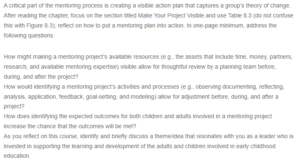Maximizing Resources and Collaboration in Mentoring Projects
Making the resources visible allows the team to assess whether the resources are sufficient to achieve the desired outcomes of the mentoring project. For example, if the team has identified a goal of providing mentorship to a large number of individuals, but the resources available only allow for a small number of mentor-mentee pairs, the team can adjust the scope of the project or seek additional resources to ensure that the project is feasible (Chu, 2014, p. 179). In addition, the team can identify potential gaps in the available resources and develop strategies to address those gaps. For example, suppose the team has identified a need for additional funding to support the mentorship program. In that case, they can explore options such as grants, fundraising, or partnerships with organizations that may be able to provide the needed resources.
Identifying a mentoring project’s activities and processes allow the project team to assess whether the planned activities and processes are sufficient to achieve the desired outcomes of the mentoring project. It can also help identify the activities and processes that allow the team to track progress and make adjustments as needed throughout the project (Chu, 2014, p. 178). Suppose the team has identified a goal of helping mentees develop specific skills or knowledge. In that case, they can use data on the activities and processes to track progress and identify areas where additional support or resources may be needed.
Identifying the expected outcomes allows the project team to assess whether the planned activities and processes are sufficient to achieve the desired outcomes. It also helps the team set specific, measurable, achievable, relevant, and time-bound (SMART) goals, increasing the chances of achieving the desired outcomes (Chu, 2014, p. 178). For example, suppose the team has identified a goal of helping children develop specific skills or knowledge. They can assess whether the planned activities and processes, such as observing and analyzing, are sufficient to support this goal.
The key theme is the importance of collaboration and partnerships. Early childhood education is a complex field that requires a wide range of expertise and resources to succeed (Mukamazimpaka, 2016). By collaborating with other organizations, educators, and community members, leaders can bring together diverse perspectives and expertise and leverage the strengths of each partner to support learning in early childhood education.
References
Chu, M. (2014). Developing mentoring and coaching relationships in early care and education: A reflective approach. Pearson Higher Ed.
Mukamazimpaka, M. C. (2016, October). Developing Mentoring and Coaching Relationships in Early Care and Education: A Reflective Approach. In International Forum Journal (Vol. 19, No. 2, pp. 139-142).
ORDER A PLAGIARISM-FREE PAPER HERE
We’ll write everything from scratch
Question
A critical part of the mentoring process is creating a visible action plan that captures a group’s theory of change. After reading the chapter, focus on the section titled Make Your Project Visible and use Table 8.3 (do not confuse this with Figure 8.3); reflect on how to put a mentoring plan into action. In one-page minimum, address the following questions:

Maximizing Resources and Collaboration in Mentoring Projects
How might making a mentoring project’s available resources (e.g., the assets that include time, money, partners, research, and available mentoring expertise) visible allow for thoughtful review by a planning team before, during, and after the project?
How would identifying a mentoring project’s activities and processes (e.g., observing documenting, reflecting, analysis, application, feedback, goal-setting, and modeling) allow for adjustment before, during, and after a project?
How does identifying the expected outcomes for both children and adults involved in a mentoring project increase the chance that the outcomes will be met?
As you reflect on this course, identify and briefly discuss a theme/idea that resonates with you as a leader who is invested in supporting the learning and development of the adults and children involved in early childhood education.

